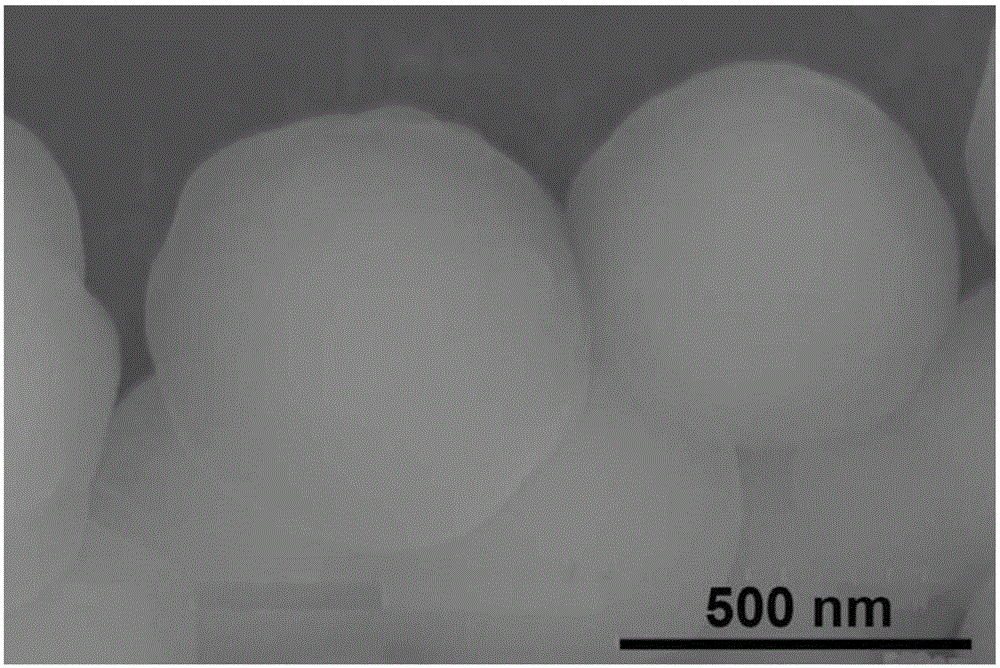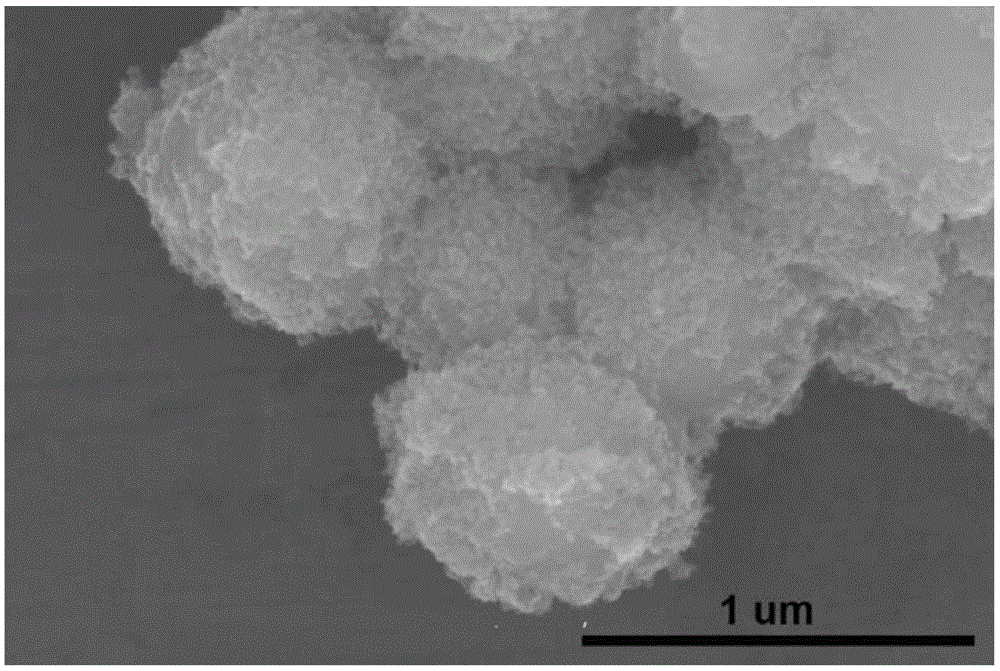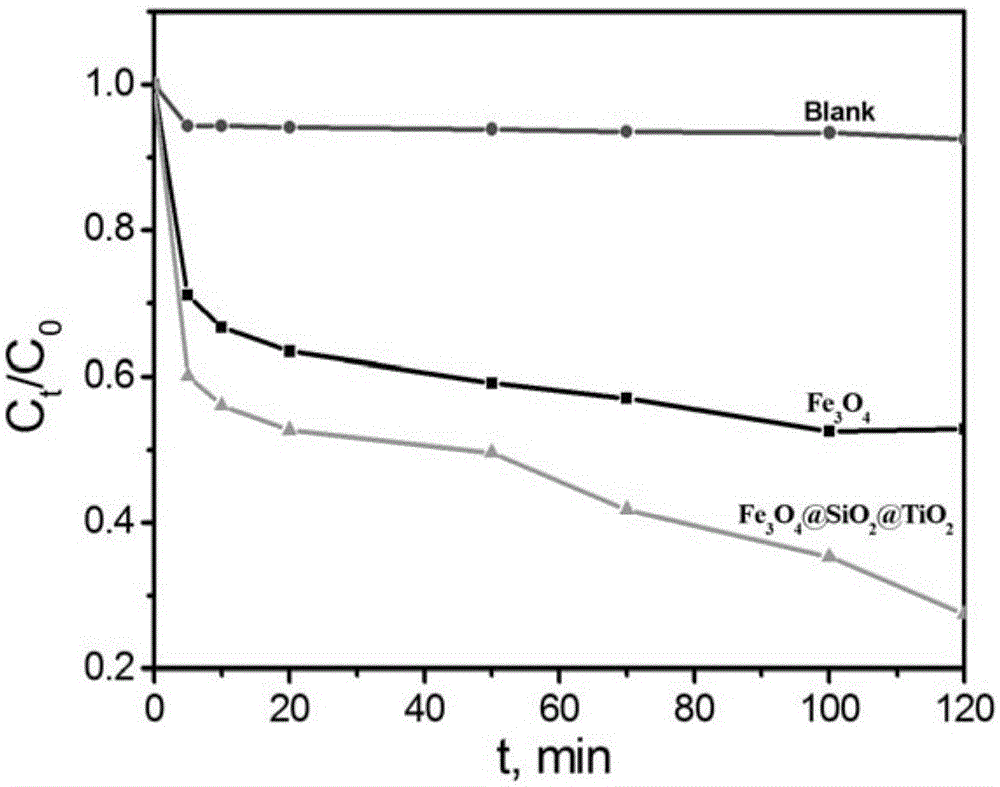Multiphase magnetic Fenton-photocatalyst and preparation method thereof and application
A photocatalyst and magnetic technology, applied in the fields of nanomaterials science and environmental science, can solve the problems of destroying the stability of TiO2, unfavorable to the catalytic reaction of wastewater, loss of photocatalytic activity, etc., and achieves good superparamagnetic properties, excellent magnetic response performance, maintain high activity
- Summary
- Abstract
- Description
- Claims
- Application Information
AI Technical Summary
Problems solved by technology
Method used
Image
Examples
Embodiment 1
[0035] (1) Fe 3 o 4 Preparation of microspheres: 1.3g FeCl 3 , 0.5g of trisodium citrate and 2.0g of sodium acetate were added to 40mL of ethylene glycol in turn, after stirring evenly, the mixed solution was transferred to a 100mL hydrothermal kettle, and after hydrothermal reaction at 200°C for 10h, it was cooled to room temperature , centrifuged to obtain Fe 3 o 4 The microspheres were washed three times with absolute ethanol and ultrapure water, and dried for later use;
[0036] (2) Fe 3 o 4 SiO 2 Preparation of microspheres: get 0.4g of Fe prepared above 3 o 4 The microspheres were ultrasonically dispersed in 150mL of absolute ethanol. After adding 1mL of ammonia water and 5mL of tetraethyl orthosilicate (TEOS) to the mixed solution, they were reacted at room temperature for 2h, cooled to room temperature, and centrifuged. Fe 3 o 4 SiO 2 The microspheres were washed three times with ethanol and ultrapure water, and dried for later use. The SEM photograph of t...
Embodiment 2
[0044] "5mL of tetraethyl silicate (TEOS)" in step (2) of Example 1 was adjusted to "3mL of tetraethyl silicate (TEOS)" in step (2) of Example 1, and all other conditions were same. reduces the amount of silicon source, making the Fe 3 o 4 SiO 2 TiO 2 SiO as an isolation transition layer in composite microspheres 2 The layer thickness decreases to about 60 nm. After treating MB simulated dye wastewater for 2 hours, the removal rate of MB is about 90%. The results are as follows image 3 shown. Visible, the SiO isolation transition layer 2 The thickness of the layer should not be too low. Otherwise Fe 3 o 4 with TiO 2 Mutual interference between layers will reduce Fe 3 o 4 SiO 2 TiO 2 Catalytic activity of composite microspheres.
Embodiment 3
[0046] Adjust the "after adding 100 uL tetrabutyl titanate (TBOT)" in step (3) of Example 1 to "after adding 50 uL tetrabutyl titanate (TBOT)" in step (3) in Example 1 , other conditions are the same. The amount of titanium source is reduced, so that Fe 3 o 4 SiO 2 TiO 2 TiO in composite microspheres 2 The layer thickness decreases to about 60 nm. After treating MB simulated dye wastewater for 2 hours, the removal rate of MB is about 68%. Visible, due to TiO 2 It has high photocatalytic activity, and its Fe 3 o 4 SiO 2 TiO 2 The content in the composite microspheres should not be too low (TiO2 layer thickness greater than 120 nm).
PUM
| Property | Measurement | Unit |
|---|---|---|
| particle diameter | aaaaa | aaaaa |
| thickness | aaaaa | aaaaa |
| particle diameter | aaaaa | aaaaa |
Abstract
Description
Claims
Application Information
 Login to View More
Login to View More - R&D
- Intellectual Property
- Life Sciences
- Materials
- Tech Scout
- Unparalleled Data Quality
- Higher Quality Content
- 60% Fewer Hallucinations
Browse by: Latest US Patents, China's latest patents, Technical Efficacy Thesaurus, Application Domain, Technology Topic, Popular Technical Reports.
© 2025 PatSnap. All rights reserved.Legal|Privacy policy|Modern Slavery Act Transparency Statement|Sitemap|About US| Contact US: help@patsnap.com



